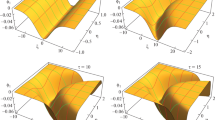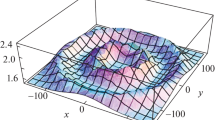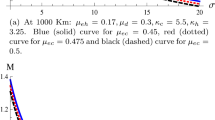Abstract
Inward and outward dust acoustic solitary (DAS) rings interactions are studied in cylindrical and spherical geometrical configurations. Wave–wave interaction specifically, solitary waves interaction in nonplanar geometry provides important information, characteristics, and nature of cylindrical DAS ring and spherical DAS ring structures. The collision between two inward and outward cylindrical/spherical DAS rings is investigated in un-magnetized plasmas, taking variable dust charge and different ion temperatures by using the extended version of Poincaré–Lighthill–Kuo (PLK) perturbation method. Time-wise interactions of cylindrical DAS rings have been depicted. The investigation assumes that derived analytical phase shifts during the head-on collision of DAS rings are directly modified by the nonplanar geometric configuration. It was noted during the investigation that variation of dust charge and different ion temperatures significantly modify the phase shifts. Thus, the dust charge variable as well as different temperature ions, play a very important role in the phase shifts which recognizes the prime objective of our investigation.











Similar content being viewed by others
REFERENCES
F. F. Chen, Introduction to Plasma Physics and Controlled Fusion (Plenum, New York, 1984).
R. J. Goldston and P. H. Rutherford, Introduction to Plasma Physics (IOP, Bristol, 2003).
F. Verheest, Waves in Dusty Space Plasmas (Kluwer Academic, Dordrecht, 2000).
E. Infeld and G. Rowlands, Nonlinear Waves, Solitons and Chaos (Cambridge Univ. Press, Cambridge, 2010).
A. A. Mamum and P. K. Shukla, Introduction to Dust Charge Fluctuation (Cambridge Univ. Press, Cambridge, 2002).
S. I. Popel, M. Y. Yu, and V. N. Tsytovich, Phys. Plasmas 3, 4313 (1996).
S. I. Popel, V. N. Tsytovich, and M. Y. Yu, Astrophys. Space Sci. 256, 107 (1998).
N. N. Rao, P. K. Shukla, and M. Y. Yu, Planet. Space Sci. 38, 543 (1990).
M. Rosenberg, Planet. Space Sci. 41 229 (1993).
U. N. Ghosh, Contrib. Plasma Phys. 62, e202100154 (2022).
A. Barkan, R. L. Merlino, and N. D’Angelo, Phys. Plasmas 2, 3563 (1995).
N. D’Angelo, J. Phys D: Appl. Phys. 28, 1009 (1995).
P. K. Shukla and V. P. Silin, Phys. Scr. 45, 508 (1992).
A. Barken, N. D’Angelo, and R. L. Merlino, Planet. Space Sci. 44, 239 (1996).
R. L. Merlino, A. Barken, C. Thompsonand, and N. D’Angelo, Phys. Plasmas 5, 1607 (1998).
V. N. Tsytovich, Phys.–Usp. 40, 53 (1997).
Q.-Z. Luo, N. D’Angelo, and R. L. Merlino, Phys. Plasmas 6, 3455 (1999).
Y. Nakamura, H. Bailung, and P. K. Shukla, Phys. Rev. Lett. 83, 1602 (1999).
S. I. Popel and M. Y. Yu, Contrib. Plasma Phys. 35, 103 (1995).
S. I. Popel and M. Y. Yu, Phys. Rev. E: Stat. Phys., Plasmas, Fluids, Relat. Interdiscip. Top. 50, 3060 (1994).
V. N. Tsytovich and O. Havnes, Comments Plasma Phys. Controll. Fusion 15, 267 (1993).
T. V. Losseva, S. I. Popel, A. P. Golub’, Yu. N. Izvekova, and P. K. Shukla, Phys. Plasmas 19, 013703 (2012).
S. I. Popel, A. A. Gisko, A. P. Golub’, T. V. Losseva, and R. Bingham, Plasma Phys. Rep. 27, 785 (2001).
S. I. Popel, A. P. Golub’, T. V. Losseva, and R. Bingham, JETP Lett. 73, 223 (2001).
S. I. Popel, A. P. Golub’, T. V. Losseva, R. Bingham, and S. Benkadda, Phys. Plasmas 8, 1497 (2001).
S. I. Popel, A. P. Golub’, T. V. Losseva, R. Bingham, and S. Benkadda, Plasma Phys. Rep. 27, 455 (2001).
S. I. Popel, S. N. Andreev, A. A. Gisko, A. P. Golub’, and T. V. Losseva, Plasma Phys. Rep. 30, 284 (2004).
S. I. Popel, T. V. Losseva, R. L. Merlino, S. N. Andreev, and A. P. Golub’, Phys. Plasmas 12, 054501 (2005).
S. I. Popel, T. V. Losseva, A. P. Golub’, R. L. Merlino, and S. N. Andreev, Contrib. Plasma Phys. 45, 461 (2005).
U. N. Ghosh, P. Chatterjee, and S. K. Kundu, Astrophys. Space Sci. 339, 255 (2012).
S. Sarkar, S. Ghosh, M. Khan, and M. R. Gupta, Phys. Plasmas 18, 093703 (2011).
U. N. Ghosh, Eur. Phys. J. Plus 137, 87 (2022).
J. K. Xue, Phys. Lett. A 320, 226 (2003).
S. K. Kundu, P. Chatterjee, and U. N. Ghosh, Astrophys. Space Sci. 340, 87 (2012).
N. J. Zabusky and M. D. Kruskal, Phys. Rev. Lett. 15, 240 (1965).
T. V. Losseva, S. I. Popel, and A. P. Golub’, Plasma Phys. Rep. 38, 729 (2012).
C. H. Su and R. M. Mirie, J. Fluid Mech. 98, 509 (1980).
P. Chatterjee, U. N. Ghosh, K. Roy, S. V. Muniandy, C. S. Wong, and B. Sahu, Phys. Plasmas 17, 122314 (2010).
U. N. Ghosh, K. Roy, and P. Chatterjee, Phys. Plasmas 18, 103703 (2011).
Y. V. Medvedev, Plasma Phys. Rep. 44, 544 (2018).
M. S. Alam and M. R. Talukder, Plasma Phys. Rep. 45, 871 (2019).
U. N. Ghosh and P. Chatterjee, Indian J. Phys. 86, 407 (2012).
S. Bansal and M. Aggarwal, Plasma Phys. Rep. 45, 991 (2019).
M. G. Shah, M. M. Rahman, M. R. Hossen, and A. A. Mamun, Plasma Phys. Rep. 42, 168 (2016).
M. S. Alam, M. M. Masud, and A. A. Mamun, Plasma Phys. Rep. 39, 1011 (2013).
S. Bansal, M. Aggarwal, and T. S. Gill, Plasma Phys. Rep. 46, 715 (2020).
P. Chatterjee and U. N. Ghosh, Eur. Phys. J. D 64, 413 (2011).
E. F. El-Shamy and M. Mahmoud, Plasma Phys. Rep. 46, 41 (2020).
U. N. Ghosh, P. Chatterjee, and R. Roychoudhury, Phys. Plasmas 19, 012113 (2012).
T. V. Losseva, S. I. Popel, and A. P. Golub’, Plasma Phys. Rep. 46, 1089 (2020).
A. A. Mamun and P. K. Shukla, Phys. Lett. A 290, 173 (2001).
U. N. Ghosh, P. Chatterjee, and B. Kaur, Z. Naturforsch., A: Phys. Sci. 77, 1 (2022).
J. Xue and H. Lang, Phys. Plasmas 10, 339 (2003).
N. Hershkowitz and T. Romesser, Phys. Rev. Lett. 32, 581 (1974).
S. Maxon and J. Viecelli, Phys. Rev. Lett. 32, 4 (1974).
U. N. Ghosh, P. K. Mandal, and P. Chatterjee, Astrophys. Space Sci. 349, 765 (2014).
U. N. Ghosh and P. Chatterjee, J. Plasma Phys. 79, 789 (2013).
E. F. EL-Shamy, F. S. Gohman, M. M. Alqahtani, and S. AlFaify, Phys. Plasmas 25, 012108 (2018).
U. N. Ghosh, P. Chatterjee, and M. Tribeche, Phys. Plasmas 19, 112302 (2012).
ACKNOWLEDGMENTS
Reviewer’s comments and constructive suggestions are gratefully acknowledged, without them the article would have not been in the present form.
Author information
Authors and Affiliations
Corresponding author
APPENDIX
APPENDIX
1.1 MATHEMATICAL DERIVATION OF PHASE SHIFT
The analytic phase shift is derived due to inward and outward soliton rings interaction by employing the extended PLK technique. According to the extended PLK technique, we substitute independent variable stretching as well as depended variable expansion followed by Eqs. (9)–(14) into the normalized governing equations, i.e., continuity equation, momentum balance equation, Poisson equation and current balance equations (1)–(4), (6)–(8). Then we obtain equations by equating the coefficient of lowest power of \(\varepsilon \) onwards.
Lowest order of ε, i.e., \({{\varepsilon }^{2}}\) coefficient gives
where
It is assumed that \({{\varphi }_{\zeta }}\) and \({{\varphi }_{\gamma }}\) are two directional solitary rings, one is outward from the initial point and another is inward towards the initial point, and compositely express \({{\varphi }_{1}}\). Then \(n_{d}^{1}\), \(u_{d}^{1}\) are expressed uniquely and given by Eqs. (A5), (A6) with the expression of \({{\varphi }_{1}}\) provided by (A4).
Next higher order of ε, i.e., \({{\varepsilon }^{3}}\) coefficient equation leads to similar equations like (A1)–(A3), the only difference is just the order of dependent variable, i.e., dependent variables involved in equations (A1)–(A3) would be of second-order instead of the first order, and consequently, the expression of the second-order dependent variable would the similar as that of (A4)–(A6).
The coefficient equations associated with the next higher order nonlinearity of ε, i.e., \({{\varepsilon }^{4}}\), after straightforward algebra we obtain
Integrating the above equation with respect to the variable \(\zeta \) and \(\gamma \) yields
The above equation (A8) gives us the information that the first and second expressions of the right-hand side lead to two KdV equations in nonplanar geometry as they are independent of γ and ζ respectively. Hence, we have
Similarly, third and fourth terms in equation (15) give us
Equations (A9) and (A10) are KdV equations in nonplanar geometry. For our convenience, we take one of their special solutions of Eqs. (A9) and (A10) as
where amplitude of two DAS rings R and L are denoted by \({{\varphi }_{R}}\) and \({{\varphi }_{L}}\) and taken as constants. The used symbols are carrying the same meaning as taken in the previous work (for detail see [59]). It is clear from Eqs. (A9) and (A10), that the fourth term contain the geometric contribution to the KdV equations and consequently to the special solution. It explores that the geometric configuration is directly depended on ν. Obviously, ν = 0 directly convert the nonplanar KdV equations (A9) and (A10) into planar KdV equations; ν = 1 gives us cylindrical KdV equation and ν = 2 leads to spherical KdV equations. Special solutions (A13) and (A14) of nonplanar KdV equations (A9) and (A10) are substituted into (A11) and (A12). Then the effect of interaction of nonplanar DAS ring is reported through phase functions \({{X}_{R}}\) and \({{Y}_{R}}\) as
where \(\zeta {{{\text{|}}}_{{t = 0}}} = \varepsilon \left( {{{r}_{L}} - {{r}_{R}}} \right)\), \(\gamma {{{\text{|}}}_{{t = 0}}} = \varepsilon \left( {{{r}_{R}} - {{r}_{L}}} \right)\), \(\zeta {{{\text{|}}}_{t}} = \) \(\left[ {\varepsilon \left( {{{r}_{L}} - {{r}_{R}}} \right) - 2ct} \right]\), and \(\gamma {{{\text{|}}}_{t}} = \left[ {\varepsilon \left( {{{r}_{R}} - {{r}_{L}}} \right) + 2ct} \right]\).
By phase shift, we mean the change in the phase \(x - \lambda t\) and \(x + \lambda t\) for the solitons moving along the positive and negative directions respectively. By setting \({{d}_{0}} = {{r}_{L}} - {{r}_{R}}\) as the initial separation between two solitary waves and assuming that \({{d}_{0}} \gg 0\), we have
As a consequence, related phase shifts which are evolved within the system is obtained as
Rights and permissions
About this article
Cite this article
Ghosh, U.N. Dust Charge Variation Effect on Solitary Rings Interaction with Two–Temperature Ions. Plasma Phys. Rep. 48, 778–788 (2022). https://doi.org/10.1134/S1063780X2280011X
Received:
Revised:
Accepted:
Published:
Issue Date:
DOI: https://doi.org/10.1134/S1063780X2280011X




